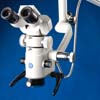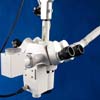Art.I.-Choroiditis With Exudation
This disease may assume in various forms.1. SIMPLE PLASTIC CHOROIDITIS
This is characterized by patches of exudation varying in size. Sometimes they are in size only a third or a fourth of the optic papilla, sometimes they exceed it. The small patches are more or less round, the large are irregularly polygonal. In the early stages these spots appear to the ophthalmoscope as whitish opacities, the borders of which gradually pass into the healthy choroid. Later, these capacities become yellowish; they are distinctly circumscribed and encircled with blackish rings which are due to the pigmentof the destroyed cells. By-and-by, as the disease advances, choroidal tissue at certain parts becomes atrophied, rendering the sclerotic visible. The spots are thenlike white mother-o-pearl, and on them we can distinguish traces of the choroidal vessels or pigment. The position of these exudations varies very much, and they may be diffused over the whole of the fundus. Sometimes the diseases begins in the equatorial portions, extending towards the centre, sometimes its course is the direct opposite.
The ophthalmoscopic sign which distinguish choroidal opacities from those of retina are the following: the retinal exudation spots have a more brilliant color, their opacity is denser, and their contour is formed by very fine radiating strie, which correspond with the direction of the nerve fibers. When the opacities are in the retina vessels are tortous, and partially disappearse under the opacities whilst they are seen to pass freely above choroidal exudation opacities without any change in their appearance. Nor is it difficult to distinguish the choroidal exudation patches from the artopic spots. The latter do not present the dull, yellowish reflection of exudations, but are brilliant, marbled, and bluish, which aspect is due to the almost denuded sclerotic. The neighborhood of the atrophic patches, besides, presents alteration of the choroidal tissue (irregularities of pigmentation), whilst exudation leaves the neighboring structure completely intact.
In the early stage of the disease the retina is not affected; at most its vessel seem to be swollen, probably a consequence of some disturbance of the circulation, due to the compression of these vessels by the exudation projecting beyond the level of the choriod. Later, we sometimes see a slight temporary alternation in its transparency, pasing of without leaving any trace.
Choroiditis with exudation is often accompanied with opacities of the vitreous body, either as very fine dust or as flakes, or even as floating membranes, which may be present from the first, or supervene at a later period.
From the attack the patients complain of mist, of fixed or movable opacities; and on functional examination we find a greater or less diminution in the visual acuteness, with contraction or deficiency in the visual field.
These different phenomena partially depend on opacities of the vitreous humor, on the functional alternation of the retina, which are due either disturbance of the circulation, or direct pressure on the retina. The neare the exudations are to the posterior pole the more do they injured central vision.
Moreover, we find sometimes sensibility of the eye to touch, and even spontaneous pain behind the eyeball during the acute stage.
Progress and Termination.-Choroiditis with exudation is a chronic affection, if the disease is of short duration and the patches not very extensive, they may pass off without leaving any trace. If absorption only takes place after some time has elapsed, the choroid remains, at the affected places, deprived of its pigment, which is accumulated round the patch. This change may give the fundus of the eye a speckled appearance.
On the other times, the choroidal tissue atrophies at the points of exudation, whilst fresh exudations are formed; and we may see in the same eye exudation patches, spots deprived of their pigment, and atrophic patches, in addition to the irregular masses of pigment which surround these patches, brownish or reddish spots are also seen, probably indicating hemorrhage from the chorio-capillaris.
Besides the alternations in the retina and vitreous body already mentioned, the disease is sometimes complicated with iritis, this indeed may be the primary disease which extends to the choroid, in which case the evil will begin in the peripheral portions of that membrane. In those cases of irido-choroiditis, where there is sometimes very little exudation, but prolonged hyperemia, inflammations of the sclerotic are sometimes developed, which are very liable to recur. We then find prominent points on the sclerotic, which are of a violet color, and are painful to touch.
Prognosis.-In all recent cases the prognosis is good; we may hope for perfect recovery. Any alternations of the tissue which may take place do not sensibly interfere with vision. The chances of complete recovery diminish with the duration of the disease, and our prognosis should be reserved when also take into account the state of the visual field, and warn the patient of the likelihood of frequent relapses.
Etiology.- the cause of this affection are often obscure; it is frequently met co-existing with affections of the general health, in women in conjunction with the painful menstruation, after puerperal fever, during pregnancy, and at the change of life. It has also been attributed to the syphilitic diathesis, which, however, generally gives rise to another form of choroiditis with exudation, which will be describe in due course.
Treatment.- There must be in the first place a very careful inequity into casual indications, so that we may suit our remedies to the general condition. Having satisfied ourselves as to these, we must order absolute rest for the eyes. If the beginning of the disease has been acute, and especially if from the very commencement there be a central scotoma, mercury is urgently demanded (calomel and friction with mercurial ointment); diaphoresis in order to bring about the absorption of the exudation. The defect in vision often rapidly disappears. The local hyperemia is best checked by blood-letting, by means of Heurteloup’s artificial leech. If the disease be of old standing, we must ascertain if there are any recent exudations, and if such are found to exist, we must follow the same treatment as In acute cases. If the exudation has been absorbed, or if there only remain atrophic patches, mercurial preparations are of no benefit. We then try the effect of the application of Heurteloup’s apparatus, succeeded by four-and-twenty to thirty-six hours’ rest, and where the vision is improved we repeat the application every six or eight days. Our general treatment should be suited to the indications of the patients state of health (iodide of potassium or of iron, sublimate).
Iritic and sclerotic complications should be treated according to the rules laid down when speaking of these diseases.
2. DISSEMINATED CHOROIDITIS
By means of the ophthalmoscope we find whitish spots, about the size of a pin head, situated near the posterior pole of the eye, or in the periphery; sometimes they are isolated, sometimes very closely united into groups, but separated from each other by deeply colored margins. They are situated immediately behind the retina, and are formed by exudation which displaces the pigment; besides these small whitish spots we sometimes find more deeply colored or reddish spots. Disseminated choroiditis very readily spreads to the retina (chorioretinitis) which loses its transparency; the vessels becoming hyperaemic and tortuous. A still more frequent and almost pathognomonic complication of the diseases is the formation of opacities in the vitreous body, in the form of fine granules, threads, or membranes. They appear suddenly and hide the fundus of the eye. In a short time they pass off, reappearing in the course of the disease.
The disturbance of vision is very considerable; sometimes the patients complain of a general mist, sometimes of a floating cloud which momentarily hides objects from them, sometimes of luminous apparitions (photopsia and chromopsia).
At the other times, examination reveals the existence of peripheral contraction of central deficiency (scotoma) in the field of vision. When there is a large central scotoma the power of perceiving colors exudations correspond with, or are in the neighborhood of, the macula, the central visual acuteness is very greatly impaired, and objects seem to the patient to be deformed (metamorphopsia) or diminished in size (micropsia).
Prognosis and Termination.- This disease runs a chronic course with acute exacerbations. If properly treated from the first, it may pass of without leaving any trace; but it may steadily progress till there is atrophy of the choroid, which may also be brought about by frequent relapses. If the retina has been involved in the disease, we may have atrophy of that membrane also, and even of the optic nerve. Opacities of the vitreous body may reamin after the primary disease has been cured.
Prognosis.- this depends on the stage of the disease and the alterations which have been already produced. It is absolutely bad where there is atrophy of the choroid and retina, and very unfavorable if the macula has been the seat of exudation for any length of time. In recent cases, on the other hand, the prognosis is extremely good, for although the exudation may occupy the entire fundus, proper treatment will ensure its complete absorption, and the restoration of vision to its normal state. Relapses are frequent.
Etiology.-In most cases, this disease is of syphilitic origin. It often supervenes at a longer or shorter interval after a syphilitic iritis and we have observed it also in children with hereditary syphilis, suffering at the same time from, or having been previously attacked by, parenchymatous corneitis.
Treatment.-When we have to deal with a diathesis, we must begin our treatment with anti-syphilitic remedies (inunctions or subcutaneous injections), using for two or three months small doses of the sublimate (1/12 grain daily), iodide of potassium (15 to 30 grains daily). The hyperemia may be controlled with Heurteloup’s apparatus, dry cupping, sinapisms, etc.
The liability to relapse renders it necessary that for a lengthened period we should carefully watch the condition of the patient, we should either follow a course of tonic treatment, or administer laxatives and diaphoretics.
Regular diaphoresis, induce by the subcutaneous administration of pilocarpine, and darkening the room which the patients inhabits, are often of the greatest service.
Absolute rest to the eyes, the use of smoked glasses, and careful management of the visual power, even for some time after complete restoration, are necessary if we would avoid dangerous hyperemia and relapses.
If after recovery we find the vision is decreased, and if the defect seems to be stationary, we sometimes improve matters by a series (10 to 12) of strychnine injection in the temple.
3. AREOLAR CHOROIDITIS (FORSTER).
This special form of choroiditis with exudation has for its anatomical characteristic the formation of prominent round specks in the choroid, above which the retina becomes atrophied. These specks are composed of a transparent, areolar and colorless tissue. To the opthlmoscope their appearance varies with the stage of the disease. At first, they appear as black pigment spots, yellow at the centre, and surrounded with a red hyperemic ring.
At a later stage, these spots become yellowish, are surrounded with pigment, and at the same time we have some very large atrophic patches, traversed by choroidal vessels, with here and there masses of pigment. The disease is always localized round and optic nerve, and in the neighborhood of the macula.
This disease is only a special form of exudative choroiditis, and there is no other peculiary either as regards its symptoms of treatment.
Back to Resources
call toll-free:  or email
or email

 or email
or email
Categories
Categories
Dental
Dental Microscopes
Dental Microscopes
Ophthalmic
Ophthalmic Microscopes
Ophthalmic Microscopes
Gynecology
Gynecology Colposcopes
Gynecology Colposcopes




